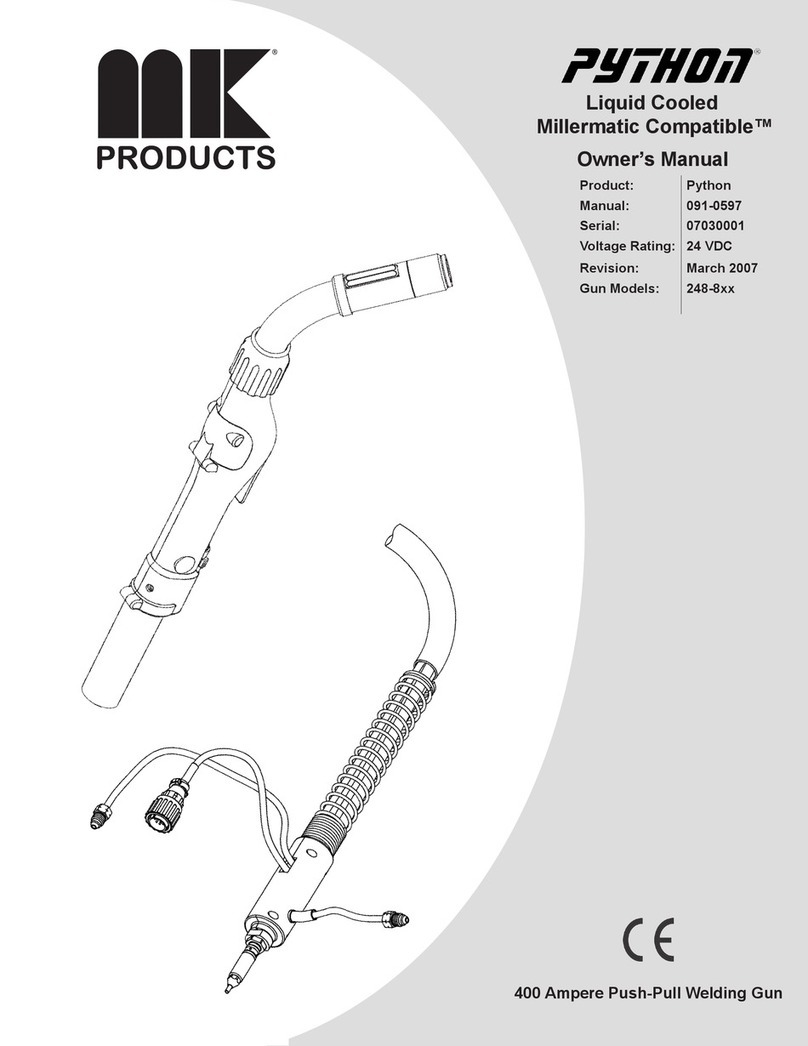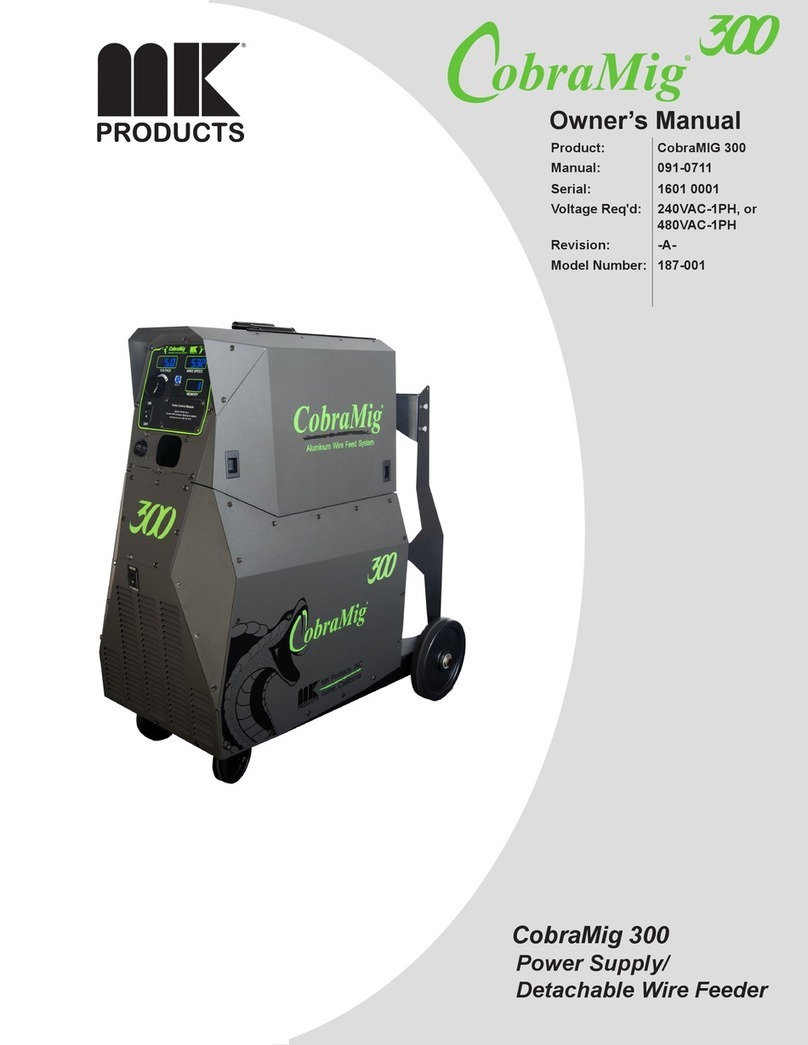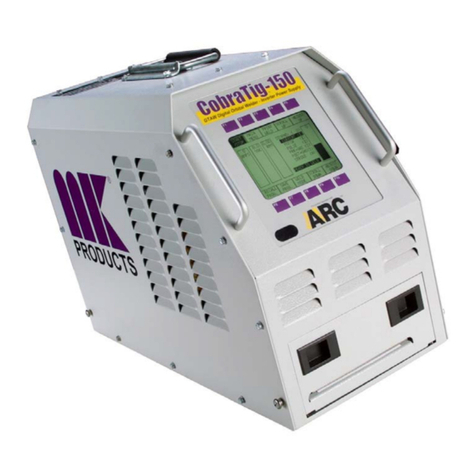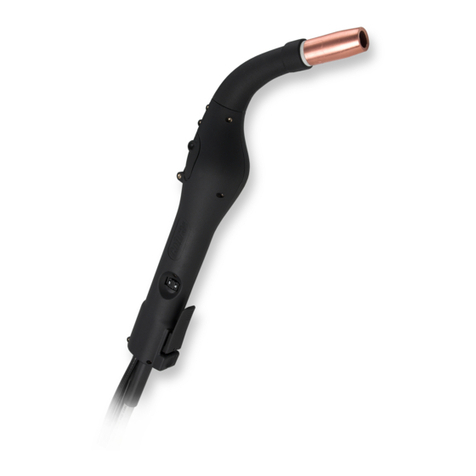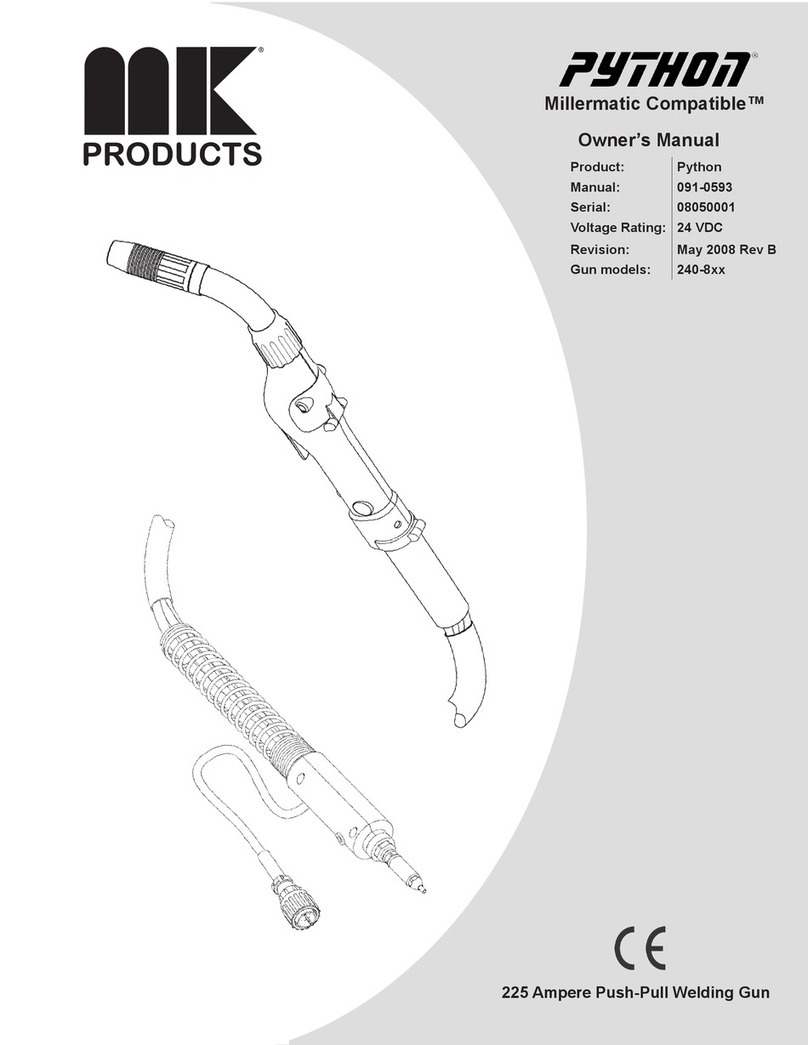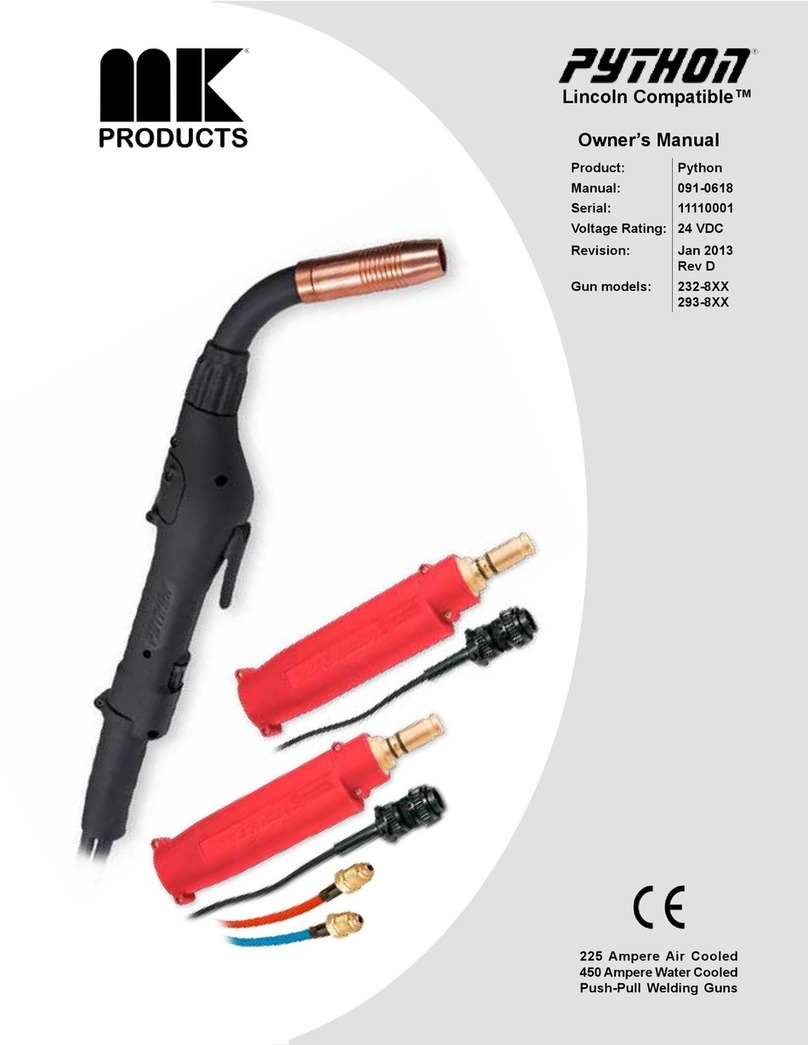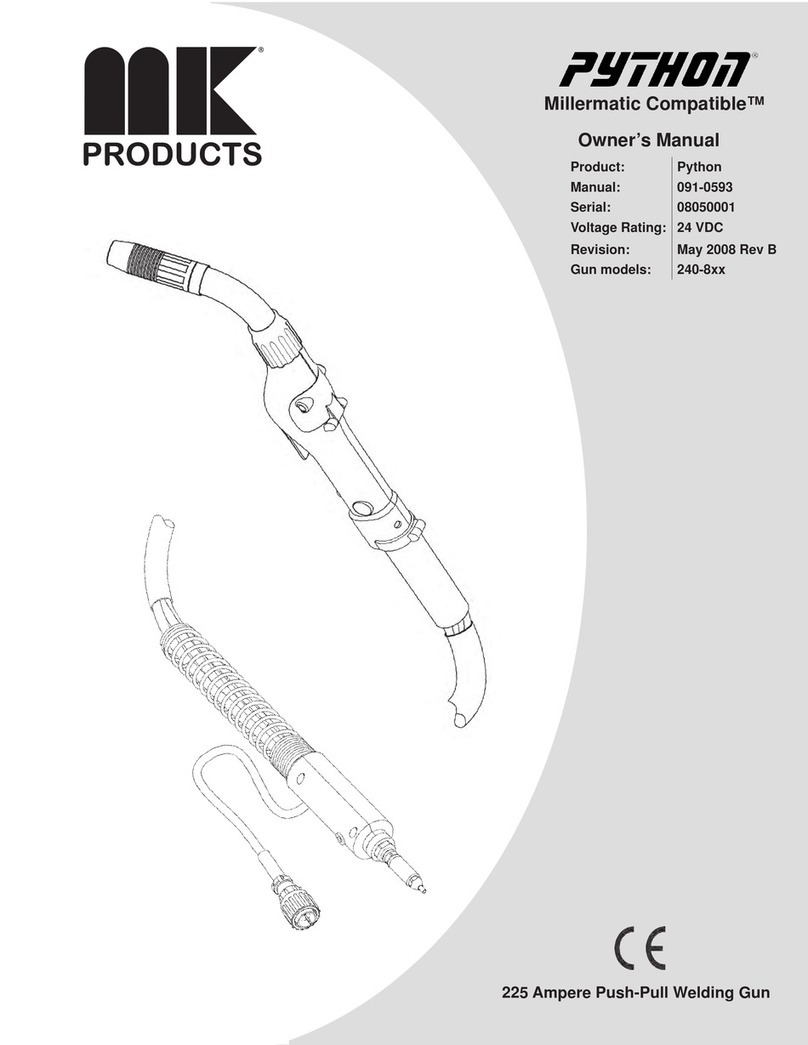
CobraTig®150 Owner's Manual - Page iii
operator invites trouble. The equipment
carries high currents at signicant volt-
ages. The arc is very bright and hot.
Sparks y, fumes rise, ultraviolet and
infrared energy radiates, weldments are
hot,andcompressedgasesmaybeused.
The wise operator avoids unnecessary
risks and protects himself and others
from accidents.
A. Burn Protection
Comply with precautions in 1-2.
The welding arc is intense and visibly
bright. Its radiation can damage eyes,
penetrate lightweight clothing, reflect
from light-colored surfaces, and burn
the skin and eyes. Skin burns resemble
acute sunburn; those from gas-shielded
arcs are more severe and painful.
DON’T GET BURNED; COMPLY WITH
PRECAUTIONS.
1. Protective Clothing
Wear long-sleeve clothing in addition to
gloves, hat, and shoes. As necessary,
use additional protective clothing such
as leather jacket or sleeves, ameproof
apron, and re-resistant leggings. Avoid
outer garments of untreated cotton.
Bare skin protection. Wear dark, sub-
stantial clothing. Button collar to protect
chest and neck, and button pockets to
prevent entry of sparks.
2. Eye and Head Protection
Protect eyes from exposure to arc. Eyes
maybedamagedbyradiantenergywhen
exposed to the electric arc, even when
not looking in the direction of the arc.
Never look at an electric arc without
protection.
Welding helmet or shield containing a
lter plate shade no. 12 or denser must
be used when welding. Place over face
before striking arc.
Protect filter plate with a clear cover
plate.
Cracked or broken helmet or shield
should NOT be worn; radiation can be
passed through to cause burns.
Cracked, broken, or loose lter plates
must be replaced IMMEDIATELY. Re-
place clear cover plate when broken,
pitted, or spattered.
Flashgoggleswithside shields MUSTbe
worn under the helmet to give some pro-
tection to the eyes should the helmet not
be lowered over the face before an arc
is struck. Looking at an arc momentarily
withunprotectedeyes (particularly a high
intensity gas-shielded arc) can cause a
retinal burn that may leave a permanent
dark area in the eld of vision.
3. Protection of Nearby Personnel
Enclosetheweldingarea. Forproduction
welding,aseparateroomorenclosedbay
is best. In open areas, surround the op-
eration with low-reective, noncombus-
tible screens or panels. Allow for free air
circulation, particularly at oor level.
Viewing the weld. Provide face shields
forallpersons who will be looking directly
at the weld.
Othersworkingin area. See that allpersons
are wearing ash goggles.
Before starting to weld, make sure that
screen aps or bay doors are closed.
B. Toxic Fume Prevention
Comply with precautions in 1-2B.
Generator engine exhaust must be vented
to the outside air. Carbon monoxide can
kill.
C. Fire and Explosion Prevention
Comply with precautions in 1-2C.
Equipment’s rated capacity. Do not over-
load arc welding equipment. It may over-
heat cables and cause a re.
Loose cable connections may overheat or
ash and cause are.
Never strike an arc on a cylinder or other
pressurevessel. Itcreatesabrittleareathat
cancauseaviolentrupture or lead to such a
rupture later under rough handling.
D. Compressed Gas Equipment
Comply with precautions in 1-2D.
E. Shock Prevention
Exposed electrically hot conductors or
other bare metal in the welding circuit, or
in ungrounded, electrically-HOT
equipmentcanfatallyshockapersonwhose
body becomes a conductor. DO NOT
STAND, SIT, LIE, LEAN ON, OR TOUCH a
wet surface when welding without suitable
protection.
To protect against shock:
Keep body and clothing dry. Never work
in damp area without adequate insulation
against electrical shock. Stay on a dry
duckboard, or rubber mat when dampness
or sweat cannot be avoided. Sweat, sea
water, or moisture between body and an
electrically HOT part - or grounded metal
- reduces the body surface electrical resis-
tance, enabling dangerous and possibly
lethal currents to ow through the body.
1. Grounding the Equipment
When installing, connect the frames of
each unit such as welding power source,
control, work table, and water circulator to
the building ground. Conductors must be
adequate to carry ground currents safely.
Equipment made electrically HOT by stray
currents may shock, possibly fatally. Do
NOT GROUND to electrical conduit, or to a
pipe carrying ANY gas or a ammable liquid
such as oil or fuel.
Three-phase connection. Check phase
requirement of equipment before install-
ing. If only three-phase power is available,
connectsingle-phaseequipmenttoonlytwo
wires of the three-phase line. Do NOT con-
nect the equipment ground lead to the third
(live) wire, or the equipment will become
electrically HOT - a dangerous condition
that can shock, possibly fatally.
Beforewelding,checkground for continuity.
Besureconductors are touching bare metal
of equipment frames at connections.
If a line cord with a ground lead is provided
with the equipment for connection to a
switch box, connect the ground lead
to the grounded switch box. If a three-
prong plug is added for connection to a
groundedmating receptacle, the ground
lead must be connected to the ground
prong only. If the line cord comes with a
three-prongplug,connect to a grounded
mating receptacle. Never remove the
ground prong from a plug, or use a plug
with a broken ground prong.
2. Connectors
Fully insulated lock-type connectors
should be used to join welding cable
lengths.
3. Cables
Frequently inspect cables for wear,
cracks, and damage. IMMEDIATELY
REPLACE those with excessively worn
or damaged insulation to avoid possibly
lethal shock from bared cable. Cables
with damaged areas may be taped to
give resistance equivalent to original
cable.
Keep cable dry, free of oil and grease,
and protected from hot metal and
sparks.
4. Terminals and Other Exposed
Parts
Terminals and other exposed parts of
electrical units should have insulating
covers secured before operation.
5. Electrode Wire
Electrode wire becomes electrically
HOT when the power switch of gas
metal-arc welding equipment is ON and
welding gun trigger is pressed. Keep
hands and body clear of wire and other
HOT parts.
6. Safety Devices
Safety devices such as interlocks and
circuit breakers should not be discon-
nected or shunted out.
Beforeinstallation, inspection, or service
of equipment, shut OFF all power, and
remove line fuses (or lock or red-tag
switches) to prevent accidental turning
ONof power.Disconnect all cablesfrom
welding power source, and pull all 115
volts line-cord plugs.
Do not open power circuit or change
polarity while welding. If, in an emer-
gency, it must be disconnected, guard
against shock burns or ash from switch
arcing.
Leavingequipment unattended. Always
shut OFF, and disconnect all power to
equipment.
Power disconnect switch must be avail-
able near the welding power source.
